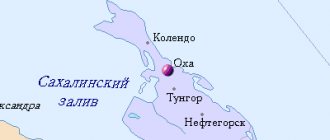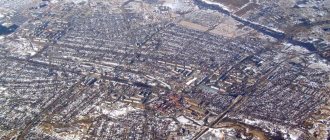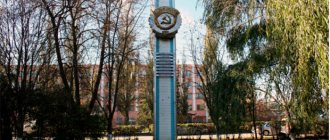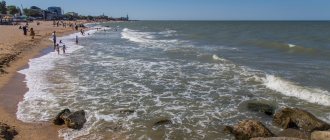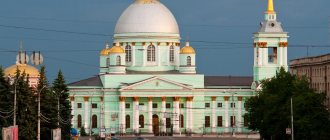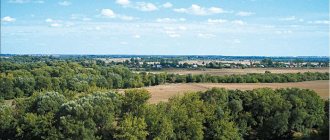general review
A small town in the Vladimir region is located on the eastern spurs of the Klinsko-Dmitrovskaya ridge, in the northeastern part of the Smolensk-Moscow Upland. The region's fourth largest city is a popular tourist destination in Russia's Golden Ring. On the picturesque banks of the Seraya River there are dozens of architectural and historical monuments of the country, churches and temples preserved from ancient times.
The city is located at almost equal distances from Moscow (111 km to the northeast) and Vladimir (125 km to the northwest). A developed transport infrastructure connects the city with the capital, regional center and other settlements in the region. There are two railway stations in Aleksandrov.
The population of Alexandrov was 59,328 people in 2017. The city is the center of the Aleksandrovskaya agglomeration with the satellite cities of Karabanovo and Strunino. The population of the agglomeration is 112 thousand inhabitants.
Alexandrov
The city of Alexandrov is the administrative center of the Alexandrovsky district, the fourth largest city in the Vladimir region with a population of 59,328 people (2017). It has satellite cities of Strunino and Karabanovo, together with which it forms the Aleksandrovskaya agglomeration with a population of about 112 thousand inhabitants. Located on the Seraya River, 125 km northwest of Vladimir, 111 km northeast of Moscow on the Moscow-Yaroslavl railway line. Alexandrov is the tourist center of the Golden Ring of Russia.
Story
In the territory where Alexandrov is now located, there have been Slavic settlements since the end of the 11th century. These lands belonged to the middle of the 12th century. into the Vladimir-Suzdal principality, then into the Pereslavl-Zalessky principality (1175-1302), and then passed into the possession of the Moscow princes. In accordance with the policy of Ivan Kalita, in the 1320s these lands began to be actively populated by settlements. The settlement that was on the site of the current city, in documents of the XIV-XV centuries. referred to as the Great Sloboda. From the beginning of the 16th century. The names New Village Alexandrovskoye and Aleksandrova (Alexandrovskaya) Sloboda appear in relation to this settlement.
Ivan III, in his spiritual letter of 1504, bequeathed the village to his son Vasily, the future Grand Duke Vasily III. It becomes a favorite vacation spot during princely trips to monasteries. Alexandrova Sloboda is beginning to be actively developed with the involvement of the best Russian and Italian craftsmen. By 1513 it had turned into a luxurious country residence of Vasily III. Thus, in 2013, Alexandrova Sloboda celebrated its 500th anniversary!
The brightest and at the same time tragic page in the history of Alexandrova Sloboda is associated with the reign of Ivan IV the Terrible, who turned it from a country residence, which it was under his father, Vasily III, into a capital one. For almost two decades, from December 1564 to November 1581, Aleksandrovskaya Sloboda served as the de facto capital of the state. Oprichnina orders, the Oprichnaya Boyar Duma and a number of other institutions functioned in it. Sloboda became the place for international negotiations and the signing of agreements in the foreign policy of Ivan IV. But state affairs alternated with torture and execution of enemies of the oprichnina in the dark dungeons of the settlement. Alexandrova Sloboda witnessed many events and dramas of the royal family.
Alexandrova Sloboda also went down in history as a cultural center of the 16th century, leaving priceless creations as a legacy for future generations. Here chronicles were created and the first books were printed, icons were painted and bells were cast, musical works were created, the best architects built white-stone temples and magnificent palaces.
In 1581, after a bloody family drama and the death of his eldest son, Ivan IV the Terrible quickly left Alexandrova Sloboda and never appeared there again.
At the beginning of the 17th century, during the Time of Troubles, Sloboda suffered greatly from the Polish-Swedish intervention: in 1609 and then in 1611-1612. it was at the mercy of the troops of Hetman Sapieha. After the liberation of the country from foreign invasions, Sloboda was a pile of ruins and fires, especially the Kremlin, palaces, and temples. Around 1635, a new wooden palace was built for Tsar Mikhail Fedorovich, which existed for almost a hundred years, burned down and was not restored.
In the second half of the 17th century. Under Tsar Alexei Mikhailovich Romanov, a women's Holy Dormition Monastery was organized on the site of the ruined Kremlin. The nuns were dismantling the remains of royal buildings from the 16th century. and used this material to build cell buildings, fences, and repair churches. Many representatives of the Romanov dynasty visited the monastery, since Alexandrova Sloboda remained a palace village.
Not far from the settlement, which went to Peter I during the division of the sovereign's villages between the brothers, on the German Hills the 17-year-old tsar conducted his amusing exercises on foot and on horseback. After the suppression of the Streltsy rebellion in 1689, by order of Peter I, his half-sister Marfa Alekseevna, accused of involvement in the rebellion, was tonsured into the Assumption Monastery. She lived as a prisoner for almost ten years in a stone chamber of four rooms attached to the Crucifixion Church-bell tower.
The daughter of Peter I, Elizaveta Petrovna, inherited the Alexandrovskaya Sloboda as personal possessions from her mother. During the reign of Anna Ioanovna (1730-1740), she was actually in exile here and lived in mansions specially built for her. At the end of the 1740s, by order of Empress Elizabeth Petrovna, the first school was opened for service people of the Alexandrovsk stud farm.
The exhibitions of the State Historical, Architectural and Art Museum-Reserve "Alexandrovskaya Sloboda" tell about the history of Alexandrovskaya Sloboda, about royalty and noble guests of the Sovereign's court, about monastic life on the site of the former royal residence.
In 1778, the palace Alexandrovskaya Sloboda received the status of the district town of Alexandrov of the Vladimir governorship. On the coat of arms granted to the city, under the provincial lion on a red background, a metalworker's vice and two anvils on the sides were depicted. This symbolized the craft character of the city, since Sloboda has been famous for its artisans since ancient times. In 2006, when the city charter was approved, the historical coat of arms of Alexandrov 1781 The city of Alexandrov was approved as the official coat of arms of the urban settlement.
Low economic weight of the city at the end of the 18th century. led it to the position of a supernumerary, as a result, in 1796 Alexandrov was turned into a settlement, and only in 1803 the city status was restored with the preservation of the previously established coat of arms.
In the first half of the 19th century. The history of the city is closely connected with the dynasties of merchants and manufacturers Baranov and Zubov, who contributed to the development of weaving production in Aleksandrov and nearby villages. In 1808, on the left bank of the Seraya River, merchant D. Zubov founded the first dyeing and calico printing factory (in the future - the Iskozh plant). In August 1823, Emperor Alexander I was passing through the city, and he stayed in the best house for those times - the merchants Stepan and Mikhail Zubov (now Streletskaya Embankment, 11).
F.N. Baranov, a merchant of the third guild, bought a plot of land in the city in the 1810s, built a house and a small textile dyeing plant on it. In 1834, he expanded the dyeing factory, which dyed cotton yarn and fabric bright red, by adding a drying room and warping machine. The history of this factory is notable for the five-day armed uprising of workers in December 1905, called the “Alexander Republic”. In honor of this event, a monument was erected in Alexandrov in 1987 (next to the Nativity Cathedral). And the weaving factory in 1922 received the name of worker F.I. Kalinin, one of the organizers of the uprising.
In 1846 I.F. Baranov founded the Troitsko-Alexandrovskaya spinning and weaving factory in the village of Karabanovo near Alexandrov (later the plant named after the Third International). In 1847, after the St. Petersburg Fair, for his great contribution to the development of manufacturing production in Russia and the high quality of fabrics, Nicholas I granted I.F. Baranov the right to depict the state emblem on his product labels. Baranovsky calicoes were known throughout Russia, and in 1862 they were awarded a medal at an industrial exhibition in London.
In 1874 A.I. Baranov founded a large textile enterprise in the village of Strunino, called the Sokolovskaya Manufactory (later the Fifth October Combine). These largest weaving enterprises in Russia were constantly expanding, workers’ settlements with social infrastructure (dormitories for workers, hospitals, schools, shops, churches, etc.) were formed around them, which today became the industrial satellite cities of Alexandrov - Karabanovo and Strunino.
A powerful stimulus for the development of Alexandrov’s economy was the construction of the Moscow-Yaroslavl railway in 1870, which allowed local goods to have free access to markets. In Alexandrov, as a large railway junction, in 1903 a brick building of the railway station and the adjacent station complex were built - warehouse buildings, a luggage compartment, a remote signal communication building, and a village for railway workers. Aleksandrovsky Station has become one of the best along the entire branch of the Moscow-Yaroslavl railway, and today is a historical and architectural monument of the city.
Economy
In the 20th century, Alexandrov turned into one of the developed industrial centers of the Vladimir region. In 1924, the Alexandrovo-Vladimir Cotton Trust of Union significance was created, which included weaving factories named after F.I. Kalinin, named after the III International (Karabanovo) and “Fifth October” (Strunino).
In 1932, radio plant No. 3 moved from Moscow to Alexandrov, which marked the beginning of the development of the radio engineering industry in the city. It produces first-class radio receivers SVD-1, SVD-9, SVG-K, etc. During the Great Patriotic War - radio stations for the needs of the Soviet army. In the post-war period, the plant launched the production of mass-produced ARZ and Record receivers, from 1949 - KVN-49 televisions, and from 1950 - Record televisions.
In the 1950-1980s, the Aleksandrovsky Radio Plant became a city-forming enterprise: it employed more than 12.5 thousand people. During these years, every tenth television produced in the country was from Aleksandrovsk.
In the 1990s, the radio plant experienced enormous economic difficulties. On its former industrial areas, several different industries and organizations were created that are still functioning today. This is, in particular, AETZ "Record", which produces lamps of the "Technolux" brand. In 1990, on the territory of the Aleksandrovsky Radio Plant, a multidisciplinary machine-building enterprise “Graviton” was also created, producing equipment for Russian Railways electric trains and urban electric transport, and various electrical products.
One of the largest enterprises in the city was the semiconductor plant named after the 50th anniversary of the USSR (later PA Eleks). Today it is NPK Daleks, which produces transistors and integrated circuits, Daleks energy-saving lamps, welding machines, and refrigeration equipment.
One of the oldest enterprises in Alexandrov is the artificial leather plant (Iskozh, founded in 1808), which was the first in the country to master the technology of producing leather substitutes. Since 1954, he, the only one in the Soviet Union, produced artificial karakul. In 1987, for the first time in the country, the plant began producing knitted cotton gloves with PVC coating to protect hands. Since 1990, the production of linoleum has been mastered (a joint Swiss-Italy production line). The Aleksandroviskozh enterprise continues to produce artificial soft leather (awning and upholstery materials) and linoleum in small quantities, but is experiencing great economic difficulties.
At the end of the 1950s, the All-Union Scientific Research Institute for the Synthesis of Mineral Raw Materials (VNIISIMS) was created in Aleksandrov, producing artificial quartz crystals, the technology and products of which had no analogues in the world for a long time. He also produced products made from crystals - diamond tools, quartz resonators, crystal blanks of various cuts. Semiconductor diamond single crystals were of significant interest for the production of high-precision devices. Artificial gems, analogues of natural stones, used in jewelry were also produced. Unfortunately, the company went bankrupt in 2007.
One of Alexandrov’s newest enterprises is a large Russian Turkish factory that produces LCD TVs, washing machines, refrigerators, stoves, dishwashers and air conditioners.
Alexandrov – “the capital of the 101st kilometer”
In the 20th century Alexandrov also became known as the “capital of the 101st kilometer”: during the years of Stalinist political repression, many cultural and scientific figures, human rights activists were forced to live in the city, who, after being released from prisons and camps, did not have the right to settle in cities less than 100 km away. kilometers from Moscow. Among them were, for example, the artist Viktor Toot, translator Boris Leitin, architect and archaeologist Pyotr Baranovsky, physical chemist Lev Polak and others. Alexandrov, located just 111 km from Moscow, was an ideal place of residence in this situation. From here it was possible, at least occasionally, to sneak out to Moscow to meet relatives, receive help, visit theaters, etc.
Famous people
Many famous people in Russia are associated with Alexandrov. At the beginning of the 20th century. Russian writer A.I. lived in Alexandrov. Tsvetaeva, who was often visited by her older sister, the famous poetess M.I. Tsvetaeva (now in the house where they lived there is the Literary and Art Museum of Marina and Anastasia Tsvetaev). Born in Alexandrov: A.K. Gertsyk (1874-1925) – Russian poetess, prose writer, translator; V.P. Zubov (1900-1963) - Russian and Soviet historian, philosopher, doctor of art history, encyclopedist and translator, who went down in the history of Russian humanities as the “Russian Leonardo”, thanks to the depth and versatility of his scientific interests, etc. An Honorary Citizen of the city of O lives in Alexandrov .IN. Danilova is a Russian skier, Honored Master of Sports, two-time Olympic champion, four-time world champion in cross-country skiing.
Attractions
Alexandrov, as a city with an ancient history, has many attractions of interest to tourists. This is, first of all, the palace and temple complex of Aleksandrovskaya Sloboda, which is part of the museum-reserve of the same name. On its territory such prominent monuments of Russian architecture have been preserved as the earliest stone church of Alexandrov - Trinity Cathedral (1513), the first stone tented Old Russian temple of the early 16th century. – Church of the Intercession, Crucifixion Church-bell tower (1560s) and Marfin’s Chambers (XVII century), Assumption Church (XVI-XVII centuries). The complex is surrounded by powerful walls with four corner towers and the gate church of Fyodor Stratilates (1680s), belonging to the Spaso-Uspensky Convent of the 17th century.
Other architectural monuments have also been preserved in the central part of the city. Here are the Nativity of Christ Cathedral (1696), the Church of the Bogolyubskaya Icon of the Mother of God (1800), the estate of the merchant A.M. Pervushina of the 19th century, in which the Aleksandrovsky Art Museum is located.
Author: V. Korolkova
origin of name
There is no generally accepted version of the origin of the city's name; back in the 19th century, local historians put forward several theories. According to one legend, Grand Duke Alexander Nevsky set up a camp at this place several times and “camped.” Then the village of Alexandrovo was founded here, named after the founder. According to another version, the area could have been named after the owner - Prince Alexander of Rostov, great-great-grandson of Ivan Kalita. The prince had the nickname Khokholok, and in his estate, near the territory of modern Aleksandrov, the village of Khokhlovka has been located since that time. That’s why the area nearby was named Alexandrovo. True, there was another owner of these places - boyar Alexander Vladimirovich, who lived in the 15th century.
The records of scribes in 1473 mention that the childless boyar Alexander Ivanovich Starkov left his estate to his brother Alexei. The center of the volost moved to the New village of Aleksandrovskoye, the village of Starkov began to be called “Old Sloboda”. This is the version of local historians.
History of the settlement
It is believed that Alexandrov was founded in the 14th century, the first written evidence dates back to 1434, then the settlement was called Velikaya Sloboda. Then it became known as the New Village of Alexandrovskoye and Alexandrovskaya Sloboda. Due to its proximity to Moscow, the settlement was often used by Russian tsars for recreation. In 1509-1515, under Ivan III, a palace and temple complex was built, from which 4 churches have survived to this day.
Since the autumn of 1565, Ivan the Terrible lived here; Aleksandrovskaya Sloboda became the political and cultural center of the Russian state. In 1581, he left the settlement forever after Tsarevich Ivan died here. In 1635, a wooden palace was built for Tsar Mikhail Romanov, which stood for a hundred years. From 1729 to 1741, the future Empress Elizaveta Petrovna lived in the settlement, exiled here by her cousin, Empress Anna Ioannovna.
City `s history
Alexandrov became a district town on September 1, 1778 in accordance with the decree of Catherine the Great. In 1870, a railway was built through it, connecting the city with Moscow and Yaroslavl. Industry developed rapidly, manufactories, factories, profitable, commercial and government buildings were built.
In Soviet times, Alexandrov was the center of the radio engineering industry; semiconductors and the famous Soviet Record televisions were produced here. Many of the enterprises were closed in the 90s. Currently, there are about 1,400 enterprises operating in the city, with the largest volume of products coming from the electronics and electrical industries.
How to get to Alexandrov
By car:
- From Moscow along the M8 to Dvorikov, then along the P75, 110 km.
- From Yaroslavl along the M8 to Dvorikov, then along the P75, 190 km.
- From Vladimir along the M7, then along the P75 through Kolchugino, 120 km.
By train:
- From Moscow from the Yaroslavl station - every hour, the journey takes 2-2.5 hours (about 25 trains per day). There is also an express train with stops in Pushkino and Sergiev Posad (travel time 1:30-1:45 minutes). Many long-distance trains stop in Aleksandrov.
- From Yaroslavl - 3-5 trains per day, long-distance trains.
- From Ivanovo - 1 commuter train per day.
- From Vladimir - to Orekhovo-Zuevo, from where 6 trains go to Alexandrov per day.
- From Dmitrov - 4 trains per day.
By bus:
- From Vladimir there are 8 buses per day.
- From Moscow (from the VDNH metro station) 12 buses per day.
© Website “On the Roads of the Middle Way”, 2009-2021. Copying and reprinting of any materials and photographs from the site anashina.com in electronic publications and printed publications is prohibited.
Population before the revolutionary period
Since ancient times, people lived on the territory where modern Alexandrov is located. Since the 14th century, there were quite densely populated settlements here, by the standards of those years. However, reliable information has been preserved only since 1784, when the population of the city of Alexandrov was 1859 people. A significant influx of residents occurred due to the creation of weaving factories, which experienced a need for labor.
In 1897, there were already 6,810 people living in the city, the vast majority of them were Russians (6,501 people), there were 87 Ukrainians and Poles each, and 84 Jews. The population of the city of Alexandrov increased due to internal migration in connection with the construction of the railway, several factories, including the glass factory of the Mukhanov sisters and the porcelain factory of E.V. Sabanin. According to the latest pre-revolutionary data of 1913, 8,300 people lived in the city.
Population in modern times
The first data from 1920 showed that Alexandrov had 11,287 inhabitants. In 1932, Radio Plant No. 3 was moved here from Moscow, which caused a sharp increase in the population of Alexandrov from 15,200 in 1931 to 27,700 in 1939. Further, rapid population growth continued during Soviet times, which was also associated with the development of industry, especially radio engineering.
Natural growth was supplemented by the arrival of specialists from other regions of the country. In 1992, the city had a population of 68,300. The maximum number of residents in Aleksandrov was recorded in 1996 - 68,600 people. In subsequent years, the population gradually decreased. This is due to the closure of many industrial enterprises and the migration of young people to megacities. According to 2022 data, the population of Alexandrov in the Vladimir region was 59,328 residents.
Sights of Alexandrov
The city of Alexandrov is part of the Golden Ring of Russia. The main attraction of the city is the complex of the Holy Dormition Convent - Alexander Kremlin .
Address: 601652, Vladimir region, Alexandrov, Museum pr., 20 Tel/fax: (49244)2-03-97 E-mail Opening hours: daily from 9.00 to 17.00, on Friday - from 9.00 to 16.00, closed day - Monday. Website: www.kreml.alexandrov.ru
Sretenskaya Church and Hospital Building in the Holy Dormition Convent
Cathedral of the Nativity of Christ , built in 1696, remains in the city center Its high bell tower, which was once the high-rise dominant feature of Alexandrov, was destroyed in 1929, and a cinema was opened in the cathedral. Now the cathedral is being restored. There are also plans to restore the bell tower.
Address: Vladimir region, Alexandrov, Cathedral Square, building 1
Cathedral of the Nativity of Christ
The Alexander Art Museum is located in the estate of the merchant Pervushin, built in the neoclassical style in 1873-1874. Exhibitions dedicated to the life of the provincial nobility, peasantry, folk arts and crafts of the 19th – early 20th centuries.
Address: Vladimir region, Alexandrov, st. Sovetskaya, 16 Opening hours: daily from 9.00 to 17.00 Tel./fax: (49244) 2-43-89 (excursion department)
The Literary and Art Museum of Marina and Anastasia Tsvetaev was opened in 1991. The museum reproduces the atmosphere of 1915-1917, when the Tsvetaeva sisters lived in Alexandrov.
Address: Vladimir region, Alexandrov, st. Institutskaya, house 6, bldg. 2. Opening hours: daily from 8.30 to 17.00, days off - Monday and Tuesday. Website: museum.ru/M2359
Museum of Man-Made Stone VNIISIMS
Address: Alexandrov, st. Institutskaya, 1 (VNIISIMS building). Tel: (49244) 92-5-46. Opening hours: from 8.00 to 17.00 daily, for organized groups - on weekends and holidays.
